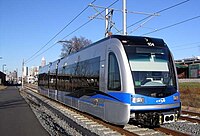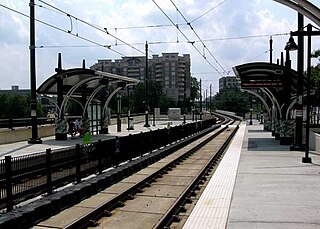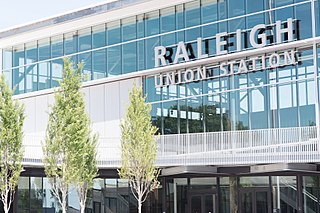Transportation in the city of Charlotte, North Carolina includes a large and growing mass transit and rail system, a major international airport, and several controlled-access highways.
Transportation in the city of Charlotte, North Carolina includes a large and growing mass transit and rail system, a major international airport, and several controlled-access highways.

Charlotte/Douglas International Airport is the 11th busiest airport in the world, as measured by traffic. [1] It is served by many domestic airlines, as well as international airlines Air Canada and Lufthansa, and is the second largest hub for American Airlines. Nonstop flights are available to many destinations across the United States, as well as flights to Canada, Central America, the Caribbean, Europe, Mexico, and South America.
Charlotte's central location between the population centers of the northeast and southeast has made it a transportation focal point and primary distribution center, with two major interstate highways, Interstate 85 (I-85) and I-77, intersecting near the city's center. Charlotte's beltway, designated I-485, has a total circumference of approximately 67 miles (108 km). Within the city, the I-277 loop freeway encircles Charlotte's uptown (usually referred to by its two separate sections, the John Belk Freeway and the Brookshire Freeway) while Charlotte Route 4 links major roads in a loop between I-277 and I-485.
Trade Street and Tryon Street are the central thoroughfares though Uptown Charlotte. The intersection of Trade and Tryon marks the center point of the city, dividing the city's first four wards.
Charlotte Route 4 is a partial ring road utilizing many existing two-lane roads around the south and east sides of the city. It is denoted by a pentagonal county road shield, with a green background and the city's crown logo above the number.
Other major thoroughfares include: Albemarle Road (part of NC 24 and NC 27), Arrowood Road, Atando Avenue, Beatties Ford Road, Billy Graham Parkway, Brookshire Boulevard (part of NC 16), Carson Boulevard, Central Avenue, Charlottetowne Avenue, Clanton Road, Davidson Street, East Boulevard, Eastway Drive, Elizabeth Avenue, Fairview Road, Freedom Drive (part of NC 27), Graham Street (part of U.S. Route 29 (US 29) and NC 49), Hawthorne Lane, Idlewild Road, Independence Boulevard (part of US 74 and NC 27), Johnston Road, Kenilworth Avenue, Kings Drive, LaSalle Street, Lawyers Road, Little Rock Road, Mallard Creek Road, McDowell Street (part of NC 27), Mint Street, Monroe Road, Morehead Street (part of US 29 and NC 27), Mt. Holly Road (part of NC 27), Nations Ford Road, Nevin Road, Oaklawn Avenue, Park Road, Pineville–Matthews Road (part of NC 51), The Plaza, Providence Road (part of NC 16), Queens Road, Randhiolph Road, Rea Road, Remount Road, Rozzelles Ferry Road, Runnymeade Lane, Sardis Road, Scaleybark Road, Selwyn Avenue, Sharon Road, Sharon-Amity Road, South Boulevard, Statesville Road (part of US 21), Steele Creek Road (part of NC 160), Stonewall Street, Sugar Creek Road, Sunset Road, Tremont Avenue, Tuckaseegee Road, Tyvola Road, University City Boulevard (part of NC 49), W.T. Harris Boulevard (part of NC 24), Wendover Road, West Boulevard (part of NC 160), Westinghouse Boulevard, Wilkinson Boulevard (part of US 74) and Woodlawn Road.
Charlotte is served daily by several Amtrak trains in each direction; two (2) long-distance services, and four (4) regional trains. [2]
The current Charlotte Amtrak station, built in 1962, is located beside the Norfolk Southern railyard, significantly north of downtown. A new centralized multimodal station, Gateway Station, is planned to serve all Amtrak, Greyhound, and some LYNX light rail services by 2027. [4] Construction of the supporting rail infrastructure, including track, signals, and the high-level platforms, was completed in late 2022, but as of May 2024 Amtrak continues to use the older station. [5] [6]
Charlotte is served by 3 freight railroads: Class I railroad s CSX Transportation and Norfolk Southern, and Class III short line Aberdeen, Carolina, and Western (ACWR). Norfolk Southern has the largest presence, with a large intermodal terminal located adjacent to Douglas International Airport opened in 2014 supplementing the existing railyard near downtown. [7] CSX also operates several yards, including two Trans-Flo transload terminals, an intermodal terminal, and the relatively small Pinoca yard. [8] [9] The ACWR operates 3 days a week from Norfolk Southern's yard; the interchange can support up to 150 cars at a time, enabling unit trains to be handled to and from ACWR customers. [10]

The Charlotte Area Transit System (CATS) is the agency responsible for operating mass transit in the Charlotte Metropolitan Area.
CATS operates light rail transit, streetcar service, express shuttles, and bus service serving Charlotte and its immediate suburbs. The LYNX system comprises a 19.3-mile long north-south light rail line known as the Blue Line and a 1.5-mile streetcar line, known as the CityLYNX Gold Line. The Blue Line was extended from the original section, I-485 to Uptown, to the UNC Charlotte campus in 2018. Bus ridership has declined in the system along with a nationwide trend in ridership [11] The 2030 Transit Corridor System Plan looks to add more light rail and bus rapid transit lines in Charlotte, as well as add commuter rail service along existing Norfolk Southern tracks to Mount Mourne. [12]

The Silver Star is a long-distance passenger train operated by Amtrak on a 1,522-mile (2,449 km) route between New York City and Miami via Washington, D.C., Richmond, Virginia, Raleigh, North Carolina, Columbia, South Carolina, Savannah, Georgia, Jacksonville, Florida, and Tampa, Florida. The Silver Star and its sister train in the Silver Service brand, the Silver Meteor, are the descendants of numerous long-distance trains that operated between Florida and New York for most of the 20th century.

The Southeast Corridor (SEC) is a proposed passenger rail transportation project in the Mid-Atlantic and Southeastern United States to extend high-speed passenger rail services from the current southern terminus of the Northeast Corridor in Washington, D.C.. Routes would extend south via Richmond and Petersburg, Virginia, with a spur to Norfolk in Virginia's Hampton Roads region; the mainline would continue south to Raleigh, Durham, Greensboro, and Charlotte, North Carolina. Since the corridor was first established in 1992, the U.S. Department of Transportation (USDOT) has extended it further to Atlanta, Georgia and Macon, Georgia; Greenville, South Carolina; Columbia, South Carolina; Jacksonville, Florida; and Birmingham, Alabama.
The Charlotte Area Transit System (CATS) is the agency responsible for public transportation in the Charlotte metropolitan area. CATS operates bus and rail transit services in Mecklenburg County and surrounding areas. Established in 1999, CATS' bus and rail operations carry about 320,000 riders on an average week. CATS is governed by the Metropolitan Transit Commission and is operated as a department of the City of Charlotte. In 2023, the system had a ridership of 13,476,600, or about 42,600 per weekday as of the fourth quarter of 2023.

The Charlotte Trolley was a heritage streetcar that operated in Charlotte in the U.S. state of North Carolina. The line ran along the former Norfolk Southern right of way between Tremont Avenue in the Historic South End in a northerly direction to its terminus at 9th Street Uptown. It ran on tracks mostly shared with the LYNX Blue Line.

Miami Intermodal Center (MIC) is an intermodal rapid transit, commuter rail, intercity rail, local bus, and intercity bus transportation hub in Miami-Dade County, Florida, just outside the Miami city limits near the Grapeland Heights neighborhood. The facility was constructed by the Florida Department of Transportation and is owned by the Miami-Dade Expressway Authority.

Charlotte station is an Amtrak station located at 1914 North Tryon Street, about 1.5 miles (2.4 km) to the northeast of Uptown Charlotte. Owned by Norfolk Southern, it is located near that railroad's yard outside Uptown.

J. Douglas Galyon Depot, also known as Greensboro station, is an intermodal transit facility in Greensboro, North Carolina. Located at 236 East Washington Street in downtown Greensboro, it serves Amtrak passenger rail and is the city's main hub for local and intercity buses.

The Charlotte Transportation Center (CTC), also known as Arena or CTC/Arena, is an intermodal transit station in Center City Charlotte, North Carolina, United States. It serves as the central hub for the Charlotte Area Transit System (CATS) buses and connects with the LYNX Blue Line and CityLYNX Gold Line. It is located on East Trade Street, Fourth Street and Brevard Street. Notable places nearby include the Bank of America Corporate Center, Belk Theater, EpiCentre, Overstreet Mall and the Spectrum Center.

Brooklyn Village, formerly Stonewall, is a light rail station in Charlotte, North Carolina. The elevated dual side platforms are a stop along the Lynx Blue Line in Uptown Charlotte.

I-485/South Boulevard is a light rail station in Charlotte, North Carolina. The elevated island platform is the southern terminus stop along the Lynx Blue Line and includes the second largest park and ride operated by Charlotte Area Transit System (CATS). Serving both Carolina Pavilion and Sterling neighborhood in the immediate area, it also serves commuters from Pineville, Ballantyne, and the South Carolina border towns.
The North Charleston Intermodal Transportation Center is an intermodal transit station in North Charleston, South Carolina, United States. It serves as the Amtrak train station for the Greater Charleston area as well as a bus terminus for the Charleston Area Regional Transportation Authority (CARTA) and Southeastern Stages, a regional intercity bus common carrier. The street address is 4565 Gaynor Avenue, and is located in the Liberty Hill neighborhood.

Raleigh Union Station is an intermodal transit station in Raleigh, North Carolina, United States. Train service began the morning of July 10, 2018. Its main building serves as an Amtrak train station, while a future adjacent building will serve as the bus terminus for GoTriangle. The station is located at the Boylan Wye, a railroad junction used by CSX and Norfolk Southern, and adjacent to the Depot Historic District in downtown Raleigh.
The I-77 Bus Rapid Transit is a proposed bus rapid transit (BRT) service, connecting the towns in northern Mecklenburg and southern Iredell counties to Uptown Charlotte, North Carolina. The BRT replaces the previously planned commuter rail service, the Lynx Red Line, that was routed along the existing Norfolk Southern O-Line right-of-way. However, several issues had arisen that included ineligibility for federal funding and Norfolk Southern refusal to allow access to its right-of-way. In 2019, after a reevaluation of the entire corridor, the Charlotte Area Transit System (CATS) decided to move forward with BRT and shelve the commuter rail; which had been met with frustration by various city leaders and residents impacted by it.
The LYNX Silver Line is a proposed east–west light rail line in Charlotte, North Carolina. The Silver Line would connect the outlying cities and towns of Belmont, Matthews, Stallings and Indian Trail to Uptown Charlotte and the Charlotte Douglas International Airport. In the refined locally preferred alternative (LPA), released in early 2021, the route is estimated to be around 29 miles (47 km), with 29 stations and one maintenance facility.

The CityLynx Gold Line is a streetcar line in Charlotte, North Carolina. A component of the Charlotte Area Transit System's Lynx rail system, it follows a primarily east-west path along Beatties Ford Road, Trade Street and Central Avenue through central Charlotte. The initial 1.5-mile (2.4 km), six-stop segment between Time Warner Cable Arena and Presbyterian Hospital opened for service on July 14, 2015. A further 2.5-mile (4.0 km) segment from the Charlotte Transportation Center to French Street, and from Hawthorne & 5th to Sunnyside Avenue, opened for service on August 30, 2021.

Charlotte Gateway Station is a future intermodal transit station in Charlotte, North Carolina, United States. Currently operating as a streetcar stop for the CityLynx Gold Line, with an adjoining bus station for Greyhound Lines intercity buses, it is the centerpiece of the overall 19-acre (7.7 ha) Station District, and it will serve Charlotte Area Transit System (CATS) bus lines, the Lynx Silver Line light rail, Amtrak intercity trains. The district will also include parking facilities, mixed-use development and an elevated greenway. Estimated at a cost of $800.1 million for full implementation of all public and private components, the project will be built in three phases, with Amtrak service tentatively scheduled to start in 2026–2027.

The Carolinian is a daily Amtrak passenger train that runs between New York City and Charlotte, North Carolina, with major stops in Philadelphia, Baltimore, Washington, Richmond, Raleigh, Cary, Durham, and Greensboro. The 704-mile (1,133 km) service is the longest state-supported route in the Amtrak system. Northbound trains leave Charlotte at breakfast time and arrive in New York in the early evening, while southbound trains leave New York during the morning rush and arrive in Charlotte in the evening.

The Piedmont is a regional passenger train operated by Amtrak and the North Carolina Department of Transportation (NCDOT), running four round trips daily between Raleigh and Charlotte, North Carolina. It is a sister train to the Carolinian, which runs from Charlotte to New York City. The Piedmont route is coextensive with the far southern leg of the Carolinian, largely paralleling Interstate 85. It operates along the far western leg of the state-owned North Carolina Railroad, which runs from Charlotte to Morehead City. Operations began in May 1995.
This article is intended to give an overview of transportation in North Carolina.

The Lynx Blue Line is a light rail line in Charlotte, North Carolina, United States. Opened in 2007, it was the first rail line of the Charlotte Area Transit System, and the first major rapid rail service of any kind in the state. The 26-station, 19.3-mile (31.1 km) line extends from its northern terminus at the University of North Carolina at Charlotte in University City through NoDa, Uptown, and South End, then runs along South Boulevard to its southern terminus just north of Interstate 485 at the Pineville city limits. The line carries an average of over 27,700 passenger trips every day and offers connections to the CATS' CityLynx Gold Line which opened in 2015.
{{cite web}}: Missing or empty |title= (help) ![]() Media related to Transport in Charlotte, North Carolina at Wikimedia Commons
Media related to Transport in Charlotte, North Carolina at Wikimedia Commons